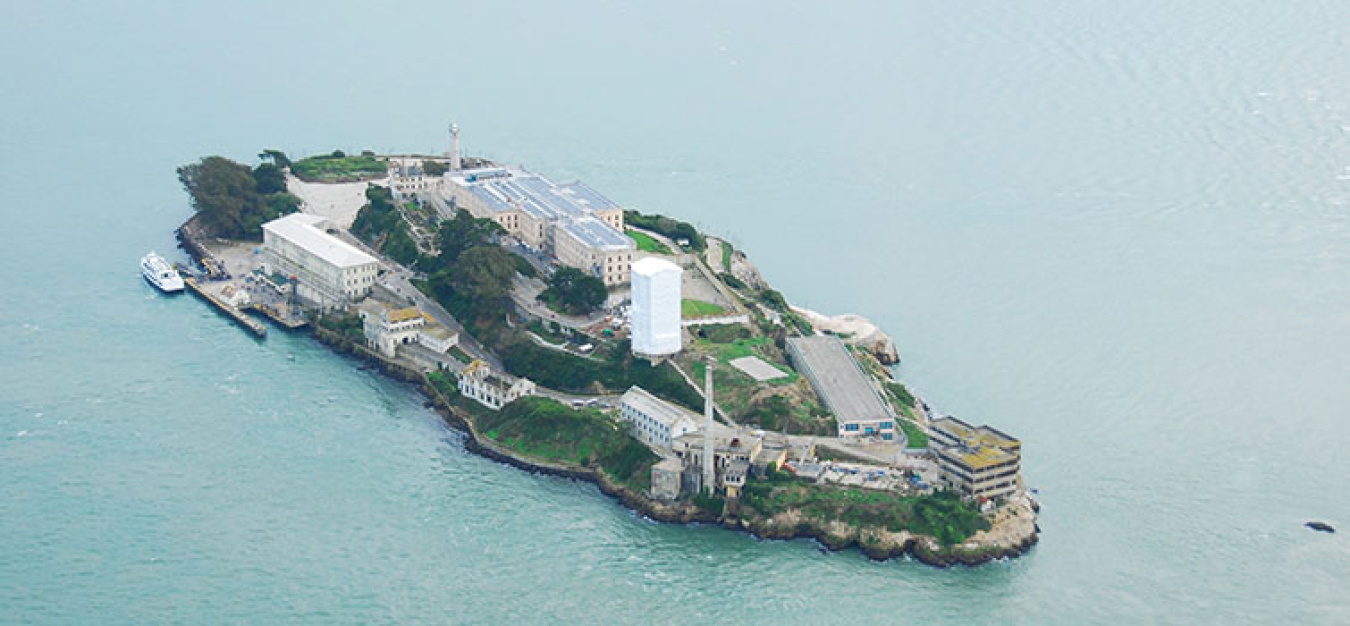
The National Park Service (NPS) decided to put the solar panels on Alcatraz's Cellhouse building.

The battery storage system, enclosed behind transparent plastic, is integral to the solar panel project on Alcatraz Island.
Sitting in the middle of the often-foggy San Francisco Bay is Alcatraz, one of the most iconic U.S. prisons. While it hasn't served as an operating prison for several decades, it now serves as host to a 307-kilowatt (kW) photovoltaic (PV) system, as well as to the 1.4 million visitors each year. The prison features 959 crystalline-silicon solar panels, powering computers, phones, appliances, pumps, and indoor and outdoor lighting, as well as a few large peak loads such as an elevator in the Cellhouse and lift at the dock.
Alcatraz Island, perched about 1 mile from San Francisco's Fisherman's Wharf, cannot operate without imported fuel, but uses only about 40% of the fuel previously used with the new PV system operating.
The National Park Service (NPS) indicates that 2,000 gallons of diesel fuel were shipped to the island each week to keep the fossil-fuel generators in the power plant humming. Astutely, Golden Gate National Recreation Area applied for and used $3.6 million in 2009 from the American Recovery and Reinvestment Act (ARRA) to begin installing a solar-powered microgrid on the island.
Now a PV array sits on the roof of the main Cellhouse building, attached to two 2,000-amp-hour battery strings and an inverter plant. The solar battery system helps power the island when the sun isn't shining. Both the PV array and the battery system are hidden from view, which were crucial to the acceptance of the design during historical preservation review.
The new PV system should produce close to 400 MWh of electricity a year, reducing greenhouse gas emissions by about 337,000 kilograms of carbon dioxide a year and reducing the time the diesel generator runs by about 60%, with the PV system contribution peaking at about 90% under favorable environmental conditions. Prior to the PV and battery system installation, the diesel generator ran "24/7." The NPS also made some energy-efficiency changes, such as better light bulbs and tweaking operations to reduce energy consumption.
According to a 2010 NPS audit of the existing cost of energy, the cost of transporting diesel fuel (maintenance and the price of the fuel itself) to the island boosted the cost of electricity for the island to 58 cents per kWh (about four times the national average). The post-PV costs are expected to be lower than 58 cents per kWh, but additional operational time is needed to verify the reduction amount.
Blackberries and honeysuckles still grace Alcatraz Island, and black-crowned night herons and slender salamanders still circle above and below. Diesel fuel use has been slashed, leading to less corrosion of pipes and smokestacks and less pollution in and around the bay.

George "Machine Gun" Kelly, Al Capone, and "Birdman" Robert Stroud-Alcatraz prison has had some infamous residents do time on the craggy island, known as "The Rock" in the middle of San Francisco Bay.
Escape to Sunlight
The project was a long time coming. The National Renewable Energy Laboratory (NREL) has been working on the potential PV project since 1995 when FEMP enlisted NREL's assistance. NREL's Applying Technologies team was requested to assess the solar resource, do a feasibility study, and mock-up what a solar installation would look like up close and from across the bay. This original project was held up due to financial and historic preservation concerns.
In that earlier proposed project, the solar panels would have been visible from an exit door in the exercise yard, and that would mar the historic nature of the New Industries Building, where Al Capone once worked a sewing machine and "Machine Gun" Kelly did the laundry and was a church altar boy while serving time on the island.
Fortunately, during the ARRA subcontract performance study meetings, it was determined that the entire PV array could be placed on the Cellhouse because PV modules had become much more efficient in the last decade. Thankfully, the 2009 ARRA funding arrangement allowed that alternative to proceed. FEMP again supplied assistance by providing optimization of the new proposed system using the HOMER computer program and assistance with acceptance and commissioning of the completed system.
NPS also looked into re-establishing a link to the electrical grid in San Francisco after an anchor had severed the original transmission link to the mainland just before the island's prison closed in 1963. Alcatraz reopened, years later as an historic site managed by NPS, with a diesel-powered electrical grid. A 2007 feasibility study conducted by researchers at the University of Washington indicated that installing an undersea transmission cable to San Francisco would be too costly, reinforcing the proposal to install PV.
